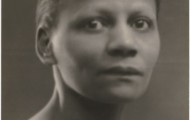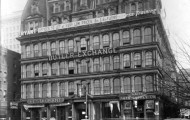A cherished revelation
In 1945, a series of Nancy Elizabeth Prophet’s sculptures were featured at the Providence Public Library’s Negro art and Literature Exhibit. This was the only exhibit her father attended, representing the first time he ever viewed her work. Despite their supposedly troubled relationship, with muted joy, he claimed her gilded Terra Cotta piece was inspired by him.
Nancy Elizabeth Prophet
Nancy Elizabeth Prophet was the first African American graduate of the Rhode Island School of Design. She became a known Harlem Renaissance Sculptor and lived in New York, Paris, and Atlanta, before returning to Rhode Island. Prophet received financial assistance from Gertrude Vanderbilt Whitney 1922 to study in Paris. It was here where she attracted the attention of artist Henry O. Tanner. He was impressed by her work and recommended her for the Harmon foundation Prize, which she won. Prophet’s work was exhibited in Paris and received notable attention. In 1932, she returned to America and began teaching at Spelman College and then Atlanta University in 1939. However, she learned quickly that opportunities in art were limited for Black women.
Prophet returned to Rhode Island in 1945 and struggled to build a profitable career and with no connections and little money, she began to work in domestic service. In 1978, work was displayed as a portion of the “Four from Providence” exhibit at the Bannister Gallery of Rhode Island College.
- written by Keila Davis
Learn more
Providence Public Library
As listed on the organization's website: "Providence Public Library differs from public libraries in most American cities in that it is privately governed and supported, but it serves the people in the best “public” sense of the word. It is owned and governed by a Board of Trustees whose members are elected for four-year terms by the Corporation.
The origins of the Providence Public Library date to June 1871 when representatives from The Franklin Society, the Rhode Island Society for the Encouragement of Domestic Industry, The Franklin Lyceum, and the Association of Mechanics and Manufacturers first met to form a Free Public Library, Art Gallery, and a Museum of Natural History. The group planned that the libraries of each society would be merged for the free use of the members and for general reference by the public."
Learn more

